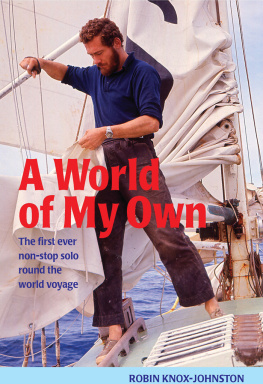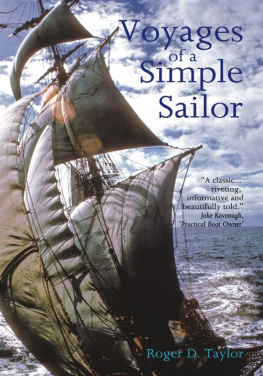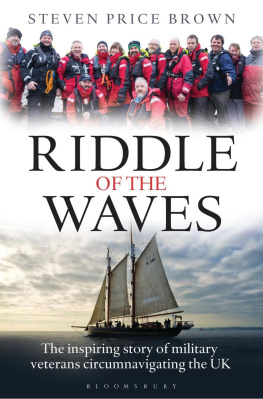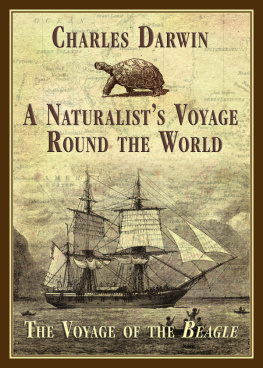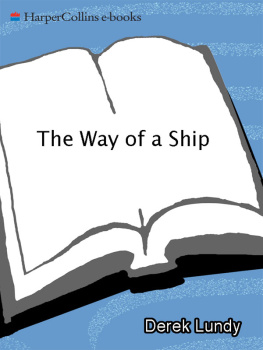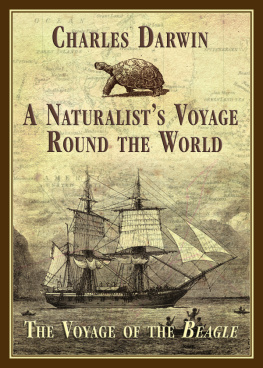
A World of My Own
The story of Robin Knox-Johnstons epic first single-handed non-stop circumnavigation in 1969 and an inspiration to countless sailors ever since.
ADLARD COLES
Bloomsbury Publishing Plc
50 Bedford Square, London, WC1B 3DP, UK
BLOOMSBURY, ADLARD COLES and the Adlard Coles logo are trademarks of Bloomsbury Publishing Plc
First published by Cassell & Company Ltd 1964
First Adlard Coles edition 2004
Copyright Robin Knox-Johnston, 1964, 2004
Robin Knox-Johnston has asserted his right under the Copyright, Designs and Patents Act, 1988, to be identifi ed as Author of this work
All rights reserved. No part of this publication may be reproduced or transmitted in any form or by any means, electronic or mechanical, including photocopying, recording, or any information storage or retrieval system, without prior permission in writing from the publishers
A catalogue record for this book is available from the British Library
Library of Congress Cataloguing-in-Publication data has been applied for
ISBN: PB: 978-0-7136-6899-5; ePub: 978-1-4729-0118-7; ePDF: 978-1-4729-0119-4
To find out more about our authors and books visit www.bloomsbury.com and sign up for our newsletters
Contents
These days, when people are thundering round the world in purpose built greyhounds in less than 100 days, it is hard to fully appreciate that it is only 35 years ago that we were not even sure that a non-stop circumnavigation was possible.
But if todays sailors have the advantage of knowing the voyage is possible and they will spend less than a third as long at sea, they suffer from the disadvantage that the spice of exploration is no longer there. Much of the sense of adventure has gone when a path has been explored, and more departs when the individual is just the leading edge and dependent on the rest of a team.
There is something satisfying about being absolute master of your own fate, knowing that if things went wrong there was no satellite phone to fall back on; once you sailed you were left entirely to your own devices.
The Golden Globe Race was unique and can never be repeated. There was just one objective to be the first to sail singlehanded non-stop around the world. It was not even a proper race; the entrants set off when they were ready and the rules were never clear. By coincidence nine people decided to try to achieve this in the same season. Francis Chichester and Alec Rose had shown that a circumnavigation with an Australasian stop was possible and had thrown down the gauntlet, but no one knew if a boat could even survive at sea for twice that distance without support. No one thought it would be easy, many thought it impossible, but therein lay its intrinsic challenge; real satisfaction comes from achieving something difficult.
There was no concept of the ideal boat for the task, no library of information to research such a voyage except what was available in the Admiralty Pilots. If they worked at all, communications were primitive, based on Medium and High Frequencies, VHF was almost unknown and was certainly not in general use at sea where the signal lamp still dominated. It could take more than eight hours just to be heard by a shore station with the limited power output of the valve radios available at the time. Weather information was non-existent; you had a barometer, the clouds and the wind direction and you worked out your own forecast from that. Satellite navigation systems had not been invented; all that was available were a sextant and chronometer, just like Captain Cook 200 years earlier. If you became ill, you had the Ship Captains Medical Guide and a small medicine chest and you had to be your own doctor unless the radio was working. Clothing was not of the high standard we can now purchase, and within a short period of time waterproofs no longer kept the water out.
Food had to be tins; there were no freeze-dried products on the market. Tins are heavier, have to be protected, and you needed at least three times the weight because the voyage was so much longer, thus slowing the boat further. Once you sailed, you might make occasional contact by radio or with another ship, but you were on your own. If you got into trouble you had to look after yourself in that pre-satellite emergency beacon age.
Everyone chose what boat they could afford or thought most suited. For me the choice came down to what I had, Suhaili. I owed the bank half her value but decided not to take them into my confidence, as once I became bitten by the idea I was not going to let anything stand in the way.
In fact Suhaili was an inspired choice. At 32 feet she is not fast, but her design (the Eric by the American William Atkins) is based on the famous Norwegian sailing lifeboats of Colin Archer. She is very tough and very seaworthy and, above all, very forgiving. Perhaps her greatest advantage, apart from the fact that I knew her well having already sailed her some 17,000 miles back from India via the Cape of Good Hope, is that she is not complicated and there were very few maintenance tasks I could not carry out myself.
The wear and tear and battering to be expected during a 300-day voyage meant that constant maintenance was essential, but this came easily to someone who had served an apprenticeship in the Merchant Navy at that time. The huge seas of the Southern Ocean were daunting, they still are, but I learned as I went how to make Suhaili as comfortable as possible in the worst storms and she brought me through.
Sturdy, seaworthy, loyal and reliable, this is really Suhailis story.
In preparing Suhaili for our voyage, during the voyage, and since my return, I have received help and kindness from many people. In acknowledging some by name, I am well aware that there are many others unnamed to whom I should also address my thanks. I can only hope that this book will in some way help to repay the debt Suhaili and I owe them.
For the voyage itself, the chief credit must go to David Waterhouse and George Greenfield; David for his encouragement when the venture was little more than a dream, and George for enabling me to turn the dream into reality.
A young person rarely has the means to pay for a voyage of this kind and nowadays must find sponsors. I should like to thank David Ascoli of Cassell and Mike Christiansen of the Sunday Mirror in London, and Charles Barnard of True Magazine and Larry Hughes of William Morrow in New York, for having the faith in Suhaili and me to persuade their respective companies to back us. The support I have received and the friendships I have made among the staffs of all four companies have been some of the incidental but happiest perks of the voyage.
The Directors and the afloat and ashore staffs of the British India Steam Navigation Company gave me every encouragement throughout; without their co-operation I could never have made the voyage.
For help in preparing Suhaili for the voyage I am indebted to David Waterhouse, Clive Henderson, Mike Souter, Richard Carpenter, Ken Parker, Bruce Maxwell, Bill Rowntree, my brother Mike, Hazel Cresswell, Stella and Jim Friend, Will Deas, many of the crew of HMS Duncan, Mr McKay of Mills & Knight, Jim Jones and the Deptford Sea Cadets, members of the Beckenham Theatre Centre, Pat Flux, and members of the staffs of Surrey Commercial Docks, Newhaven Marina, and the Falmouth Harbour Board. William Maconachie and George Gardiner of Marconi Marine, Cliff Pearson of the

